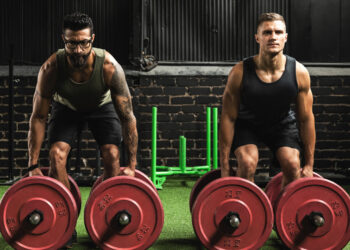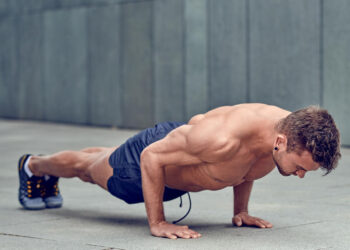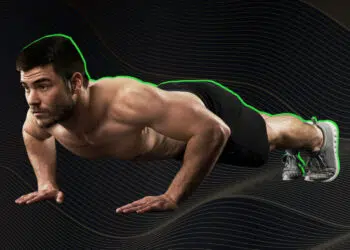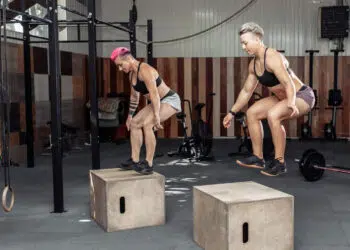Isometric exercises like plank variations are a beneficial addition to any core training routine. Aside from strengthening your midsection and hips, side planks are great for shoulder stability and challenging your mental fortitude. The great thing about this exercise is that if you find it too easy, there are some awesome variations that you can do right where you are while in the side plank position.
In this guide, we’ll go over proper movement tips, benefits, best variations, optimal sets/reps, and programming side planks.
How To Do Side Planks
A classic isometric core exercise, most gym goers or workout enthusiasts have done planks. But if you haven’t, here are step-by-step instructions to keep your form on point and the tension in the right muscle groups.
Step 1: Beginning setup
Forming a solid and comfortable base will allow you to hold planks for as long as your strength will allow.
To do it:
- Lie in a side plank position by planting your forearm on the ground and stacking one leg on top of the other to support your body weight. Your top leg should lie on top of the bottom leg so that your feet are together and pointing in the direction you’re facing. You can place the top hand on your hips or stomach for balance.
Pro tip: Keep your upper arm vertical under your armpit and close to your body for optimal support and shoulder stability.
Level Up Your Fitness: Join our 💪 strong community in Fitness Volt Newsletter. Get daily inspiration, expert-backed workouts, nutrition tips, the latest in strength sports, and the support you need to reach your goals. Subscribe for free!
Step 2: Plank hold
Now you’re ready to hold the plank position.
- Lift your hips up to form a straight line with your body and hold this position for the desired duration. We recommend planking for at least 10 seconds on one side. When you’re ready to stop, drop your hips for a short rest break and repeat for the desired number of sets.
Step 3: Switch sides and repeat
You can’t do one side and not the other. Flip over to the opposite side and complete the same number of sets.
Benefits
The benefits of this exercise surely outweigh any potential drawbacks. These are reasons to rotate side planks in your core workout rotation.
- Challenging bodyweight core exercise – Side planks and its variations are harder for some people than others. This depends on a couple factors like your body weight and level of training experience. Beginners will especially find planks to be a great challenge to their core and entire body.
- Total body exercise – While some muscles are more involved than others, side planks activate the entire body. The advantage is increased total core activation, improved muscular balance, isometric strength development from head to toe, and engagement of stabilizer muscles.
- Weight dependent – This may also be considered a con but because side planks are a bodyweight exercise, heavier people will have more resistance to work with which will make the exercise more challenging.
Drawbacks
Are there potential drawbacks to doing side planks?
- Bodyweight based – Your resistance is only as much as you weigh. This is the disadvantage of bodyweight-only exercises, however, thank goodness for more advanced variations and methods to increase resistance.
- Requires upper body, core, and glute strength – You need a solid foundation to do planks of any kind. That means your glutes, core, and upper body all need to be on the same page. Planks and side planks are a good variation for people with a little training experience.
- Not good for those with bad shoulders – If you have painful shoulders, then here are 13 ways to avoid deltoids pain in the gym. Because you’ll need to support your weight using one arm a time, healthy deltoids are a must.
Common Mistakes
Beginners especially are more prone to performing an exercise incorrectly. These are some thing to avoid.
- Overcompensating – a weak core will cause you to overcompensate by lifting your hips higher than they should be in the side plank pose. You’ll still activate your core sure but will you be as strong and efficient? Probably not.
- Bad form – Like overcompensating, when we’re not strong enough to do an exercise, we disregard proper exercise technique which is not just ineffective but also dangerous. Know your limitations and if you can’t side plank then work on your core strength or other areas causing energy leaks.
Variations
Side planks are a useful basic core exercise but we also like and recommend these variations that work all the same muscles but offer their own unique advantages.
1. Single leg side plank
Increase the total body stability requirements by doing side planks on one leg. It’s as simple as lifting the top leg up while you remain in the plank position.
2. High side plank
Elevate side bridges by supporting your weight on a fully extended arm rather than your forearms.
3. Side plank crunch
Activate more of the abdominal or six pack muscles with this side bridge crunch variation.
Level Up Your Fitness: Join our 💪 strong community in Fitness Volt Newsletter. Get daily inspiration, expert-backed workouts, nutrition tips, the latest in strength sports, and the support you need to reach your goals. Subscribe for free!
To do it:
- Get in a side plank position.
- Lift the top leg toward the ceiling.
- Simultaneously crunch the knee of your top leg and your upper body toward each other and contract the core muscles.
- Return to the starting position and repeat for the desired number of repetitions.
4. Side bridge
Get more action from your obliques by switching to side bridges. You’ll start off the same as a side plank, but instead of holding your hips up in an isometric pose, it’s more of an isotonic exercise. Therefore, you’ll perform repetitions by dropping your butt close to the floor and lifting it back up.
5. Regular plank to side plank
Instead of starting from a side plank, you can get on both forearms as you would a more conventional plank, then lift one side off the ground and twist your body into a side plank. That way you’ll enhance the activation of all muscles involved in the exercise.
6. Rolling side plank
Alternate switching from your left to right side with a rolling bridge variation. You’re essentially just turning over and from there you can do a side bridge or remain in a plank.
Programming Side Planks
Planks are a good post-training session exercise because you can finish off with a few sets of isometric holds. You still have to exert energy but there’s no movement involved which makes it a more appealing conclusion to a core or any type of training split workout session.
Related: The Best Plank Progressions and Variations for Stronger Abs
How many sets should you do?
What are the optimal number of sets for side planks? Well, it depends on a few factors such as your body weight, training level/strength, and goals. Unlike other exercises where the resistance can be adjusted, your weight doesn’t change.
- We recommend 2-4 sets depending on your experience level for best results.
Try this 30-day plank challenge
How Long Should I Plank For?
There is no perfect amount of time to hold a plank because it depends on the individual and what they’re trying to achieve. However, a major factor is your ability to hold a plank for a certain number of time.
Some people can only hold a plank for 30 seconds while Daniel Scali from Australia set the all time plank world record (male and overall) of 9 hours, 30 minutes and 1 second on August 6, 2021.
In our opinion, try to achieve a better time each time you do planks. If you can hold it for several minutes, then consider one of the more challenging variations to keep increasing your core strength.
Muscles Worked
Below are brief descriptions of the core muscles worked during side planks.
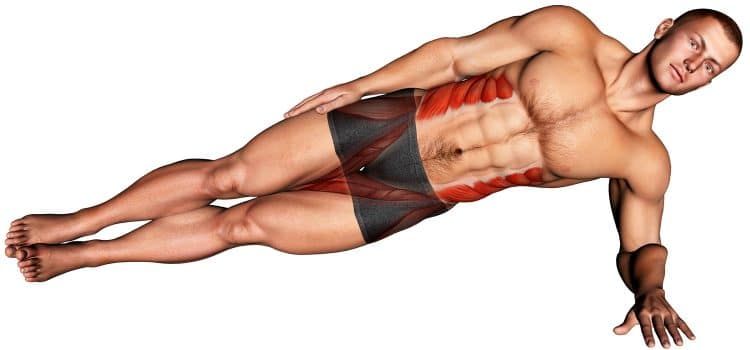
Obliques
The obliques don’t get as much of the spotlight compared to the more visually prominent abdominals or “sick pack” muscles, however, they give the midsection a complete look when well developed on a lean person. There are two sets of obliques – external and internal- located on the lateral side of the torso. External obliques are closer to the surface while internal muscles are deeper and they both allow us to twist and rotate from side to side.
Rectus abdominis
Your “six pack” muscles on the front and center of your torso are also activated during side planks, although not the main focus. Their primary function is to curl the upper body down toward the belly button (e.g., crunch) and anatomically, it’s one long, flat muscle. The abdominals are an important aesthetic and functional muscle.
Bottom Line
Get back to the basics with a simple side plank isometric exercise variation. It’s harder than it looks and a simple modification will give you something more challenging to look forward too with the variations included in this guide. Planks should be a staple core builder that fits perfectly at the conclusion of a grueling session to stimulate both physical and mental gains!




